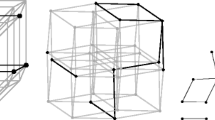Abstract
The solution graph of a Boolean formula on n variables is the subgraph of the hypercube \(H_n\) induced by the satisfying assignments of the formula. The structure of solution graphs has been the object of much research in recent years since it is important for the performance of SAT-solving procedures based on local search. Several authors have studied connectivity problems in such graphs focusing on how the structure of the original formula might affect the complexity of the connectivity problems in the solution graph.
In this paper we study the complexity of the isomorphism problem of solution graphs of Boolean formulas and we investigate how this complexity depends on the formula type.
We observe that for general formulas the solution graph isomorphism problem can be solved in exponential time while in the cases of 2CNF formulas, as well as for CPSS formulas, the problem is in the counting complexity class \(\text {C}_=\text {P} \), a subclass of PSPACE. We also prove a strong property on the structure of solution graphs of Horn formulas showing that they are just unions of partial cubes.
In addition we give a \(\text {PSPACE} \) lower bound for the problem on general Boolean functions. We prove that for 2CNF, as well as for CPSS formulas the solution graph isomorphism problem is hard for \(\text {C}_=\text {P} \) under polynomial time many one reductions, thus matching the given upper bound.
P. Scharpfenecker—Supported by DFG grant TO 200/3-1.
Access this chapter
Tax calculation will be finalised at checkout
Purchases are for personal use only
Similar content being viewed by others
Notes
- 1.
Identifying two variables corresponds to replacing one of them with the other variable.
- 2.
Boolean isomorphisms are signed permutations: they may map variables to variables and may flip variables.
- 3.
We use the same quantifier notation which is common for the classes in the polynomial time hierarchy.
References
Achlioptas, D., Coja-Oghlan, A., Ricci-Tersenghi, F.: On the solution-space geometry of random constraint satisfaction problems. Random Struct. Algorithms 38(3), 251–268 (2011)
Agrawal, M., Thierauf, T.: The Boolean isomorphism problem. In: Proceedings of 37th Conference on Foundations of Computer Science, pp. 422–430. IEEE Computer Society Press (1996)
Babai, L.: Graph isomorphism in quasipolynomial time. In: Proceedings of 48th Annual Symposium on the Theory of Computing, STOC (2016)
Bandelt, H.-J., van de Vel, M.: Embedding topological median algebras in products of dendrons. Proc. London Math. Soc. 3(58), 439–453 (1989)
Bandelt, H.J., Chepoi, V.: Metric graph theory and geometry: a survey. Contemp. Math. 453, 49–86 (2008)
Böhler, E., Hemaspaandra, E., Reith, S., Vollmer, H.: Equivalence and isomorphism for boolean constraint satisfaction. In: Bradfield, J.C. (ed.) CSL 2002 and EACSL 2002. LNCS, vol. 2471, pp. 412–426. Springer, Heidelberg (2002)
Curticapean, R.: Parity separation: a scientifically proven method for permanent weight loss. arXiv preprint. arXiv:1511.07480 (2015)
Gableske, O.: SAT Solving with Message Passing. Ph.D. thesis, University of Ulm (2016)
Gopalan, P., Kolaitis, P.G., Maneva, E., Papadimitriou, C.H.: The connectivity of boolean satisfiability: computational and structural dichotomies. SIAM J. Comput. 38(6), 2330–2355 (2009)
Green, F.: On the power of deterministic reductions to C=P. Math. Syst. Theor. 26(2), 215–233 (1993)
Jenner, B., Köbler, J., McKenzie, P., Torán, J.: Completeness results for graph isomorphism. J. Comput. Syst. Sci. 66(3), 549–566 (2003)
Köbler, J., Schöning, U., Torán, J.: Graph isomorphism is low for PP. Comput. Complex. 2(4), 301–330 (1992)
Köbler, J., Schöning, U., Torán, J.: The Graph Isomorphism Problem: its Structural Complexity. Birkhauser, Boston (1993)
Luks, E.M.: Isomorphism of graphs of bounded valence can be tested in polynomial time. J. Comput. Syst. Sci. 25(1), 42–65 (1982)
Mézard, M., Mora, T., Zecchina, R.: Clustering of solutions in the random satisfiability problem. Phys. Rev. Lett. 94(19), 197205 (2005)
Ovchinnikov, S.: Graphs and Cubes. Universitext. Springer, New York (2011)
Schaefer, T.J.: The complexity of satisfiability problems. In: Proceedings of the Tenth Annual ACM Symposium on Theory of Computing - STOC 1978, pp. 216–226. ACM Press, New York (1978)
Scharpfenecker, P.: On the structure of solution-graphs for boolean formulas. In: Kosowski, A., Walukiewicz, I. (eds.) FCT 2015. LNCS, vol. 9210, pp. 118–130. Springer, Heidelberg (2015)
Schwerdtfeger, K.W.: A computational trichotomy for connectivity of boolean satisfiability. JSAT 8(3/4), 173–195 (2014)
Valiant, L.G.: The complexity of computing the permanent. Theor. Comput. Sci. 8(2), 189–201 (1979)
Valiant, L.G.: The complexity of enumeration and reliability problems. SIAM J. Comput. 8, 410–421 (1979)
Wagner, K.W.: The complexity of combinatorial problems with succinct input representation. Acta Informatica 23(3), 325–356 (1986)
Author information
Authors and Affiliations
Corresponding author
Editor information
Editors and Affiliations
Rights and permissions
Copyright information
© 2016 Springer International Publishing Switzerland
About this paper
Cite this paper
Scharpfenecker, P., Torán, J. (2016). Solution-Graphs of Boolean Formulas and Isomorphism. In: Creignou, N., Le Berre, D. (eds) Theory and Applications of Satisfiability Testing – SAT 2016. SAT 2016. Lecture Notes in Computer Science(), vol 9710. Springer, Cham. https://doi.org/10.1007/978-3-319-40970-2_3
Download citation
DOI: https://doi.org/10.1007/978-3-319-40970-2_3
Published:
Publisher Name: Springer, Cham
Print ISBN: 978-3-319-40969-6
Online ISBN: 978-3-319-40970-2
eBook Packages: Computer ScienceComputer Science (R0)




